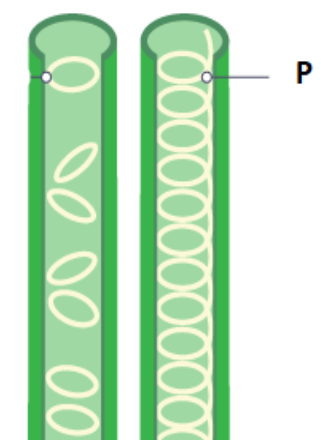
What is the function of the spiral structure P?

A. Absorption
B. Support
C. Photosynthesis
D. Transportation

Answer
463.2k+ views
Hint: The plants consist of a tissue that helps in conducting water and nutrients through its long tracheary elements. This tissue is made of tracheid and vessel elements.
Complete step by step answer: The given structure is of xylem tissue of plants. The xylem consists of distinctive xylem cells that are long tracheary elements that transport water through the soil towards the plant. It also contains vessel elements that are shorter in size and thus connects in the form of long tubes that are called vessels. The xylem cells are cylindrical dead cells that have two walls. The primary wall is made of cellulose and the secondary wall is made of lignin. The spirals shown in the diagram are of lignin. Xylem is considered as water-conducting vessels in the Angiosperms or flower-bearing plants.
Option A is Absorption. The xylem does not absorb water or nutrients rather it sucks them up throughout the length of the plant by transpirational pull or pressure flow.
Option B is support. The secondary walls of xylem do function to provide mechanical support but not significantly.
Option C is Photosynthesis. This is incorrect as xylem tracheid cells are mostly non-living at maturity and thus cannot perform photosynthesis. The function of xylem is to provide water and nutrients to plant through soil.
Option D is Transportation. It is the right option as the tracheid or lignin surrounded secondary spiral walls of xylem are employed purely in transporting water and nutrients from soil towards the plant.
Thus, the correct option is Transportation.
Note: Xylem is made of tracheids, vessels, xylem fibers, and xylem parenchyma. Each of these components has different roles to play in the plant. The tracheid cells when die or become non-living at maturity they become devoid of protoplast. The secondary walls of tracheids are laid differently based on distinct materials forming annular thickening, spiral thickening as in diagram or scalariform thickening.
Complete step by step answer: The given structure is of xylem tissue of plants. The xylem consists of distinctive xylem cells that are long tracheary elements that transport water through the soil towards the plant. It also contains vessel elements that are shorter in size and thus connects in the form of long tubes that are called vessels. The xylem cells are cylindrical dead cells that have two walls. The primary wall is made of cellulose and the secondary wall is made of lignin. The spirals shown in the diagram are of lignin. Xylem is considered as water-conducting vessels in the Angiosperms or flower-bearing plants.
Option A is Absorption. The xylem does not absorb water or nutrients rather it sucks them up throughout the length of the plant by transpirational pull or pressure flow.
Option B is support. The secondary walls of xylem do function to provide mechanical support but not significantly.
Option C is Photosynthesis. This is incorrect as xylem tracheid cells are mostly non-living at maturity and thus cannot perform photosynthesis. The function of xylem is to provide water and nutrients to plant through soil.
Option D is Transportation. It is the right option as the tracheid or lignin surrounded secondary spiral walls of xylem are employed purely in transporting water and nutrients from soil towards the plant.
Thus, the correct option is Transportation.
Note: Xylem is made of tracheids, vessels, xylem fibers, and xylem parenchyma. Each of these components has different roles to play in the plant. The tracheid cells when die or become non-living at maturity they become devoid of protoplast. The secondary walls of tracheids are laid differently based on distinct materials forming annular thickening, spiral thickening as in diagram or scalariform thickening.
Recently Updated Pages
The correct geometry and hybridization for XeF4 are class 11 chemistry CBSE

Water softening by Clarks process uses ACalcium bicarbonate class 11 chemistry CBSE

With reference to graphite and diamond which of the class 11 chemistry CBSE

A certain household has consumed 250 units of energy class 11 physics CBSE

The lightest metal known is A beryllium B lithium C class 11 chemistry CBSE

What is the formula mass of the iodine molecule class 11 chemistry CBSE

Trending doubts
The reservoir of dam is called Govind Sagar A Jayakwadi class 11 social science CBSE

What problem did Carter face when he reached the mummy class 11 english CBSE

Proton was discovered by A Thomson B Rutherford C Chadwick class 11 chemistry CBSE

In China rose the flowers are A Zygomorphic epigynous class 11 biology CBSE

What is Environment class 11 chemistry CBSE

Nucleolus is present in which part of the cell class 11 biology CBSE




